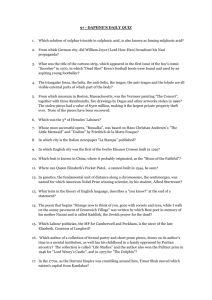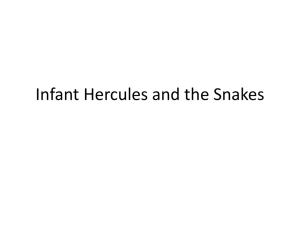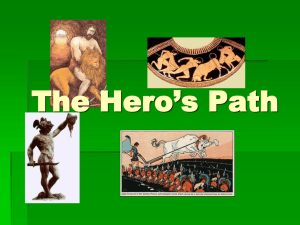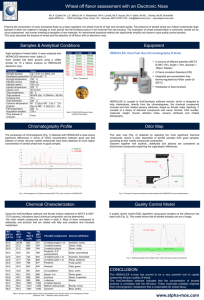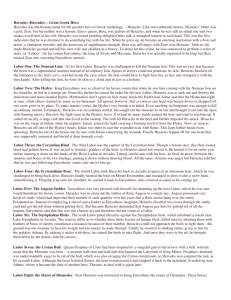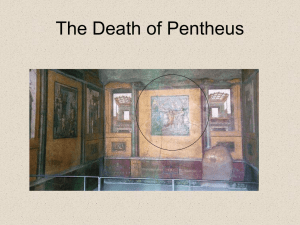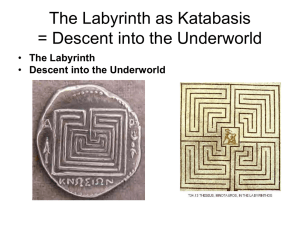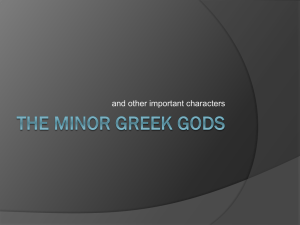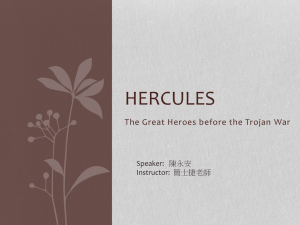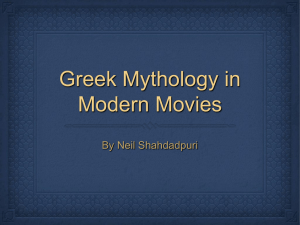Mythology-- Twelve Labors of Heracles
advertisement
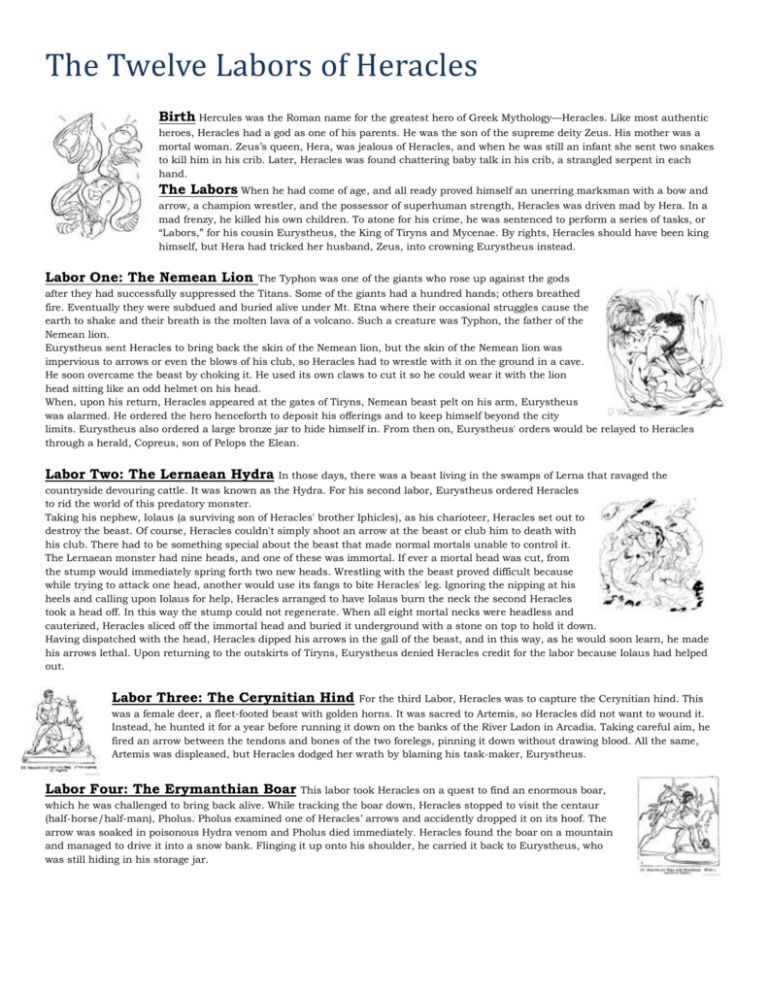
The Twelve Labors of Heracles Birth Hercules was the Roman name for the greatest hero of Greek Mythology—Heracles. Like most authentic heroes, Heracles had a god as one of his parents. He was the son of the supreme deity Zeus. His mother was a mortal woman. Zeus’s queen, Hera, was jealous of Heracles, and when he was still an infant she sent two snakes to kill him in his crib. Later, Heracles was found chattering baby talk in his crib, a strangled serpent in each hand. The Labors When he had come of age, and all ready proved himself an unerring marksman with a bow and arrow, a champion wrestler, and the possessor of superhuman strength, Heracles was driven mad by Hera. In a mad frenzy, he killed his own children. To atone for his crime, he was sentenced to perform a series of tasks, or “Labors,” for his cousin Eurystheus, the King of Tiryns and Mycenae. By rights, Heracles should have been king himself, but Hera had tricked her husband, Zeus, into crowning Eurystheus instead. Labor One: The Nemean Lion The Typhon was one of the giants who rose up against the gods after they had successfully suppressed the Titans. Some of the giants had a hundred hands; others breathed fire. Eventually they were subdued and buried alive under Mt. Etna where their occasional struggles cause the earth to shake and their breath is the molten lava of a volcano. Such a creature was Typhon, the father of the Nemean lion. Eurystheus sent Heracles to bring back the skin of the Nemean lion, but the skin of the Nemean lion was impervious to arrows or even the blows of his club, so Heracles had to wrestle with it on the ground in a cave. He soon overcame the beast by choking it. He used its own claws to cut it so he could wear it with the lion head sitting like an odd helmet on his head. When, upon his return, Heracles appeared at the gates of Tiryns, Nemean beast pelt on his arm, Eurystheus was alarmed. He ordered the hero henceforth to deposit his offerings and to keep himself beyond the city limits. Eurystheus also ordered a large bronze jar to hide himself in. From then on, Eurystheus' orders would be relayed to Heracles through a herald, Copreus, son of Pelops the Elean. Labor Two: The Lernaean Hydra In those days, there was a beast living in the swamps of Lerna that ravaged the countryside devouring cattle. It was known as the Hydra. For his second labor, Eurystheus ordered Heracles to rid the world of this predatory monster. Taking his nephew, Iolaus (a surviving son of Heracles' brother Iphicles), as his charioteer, Heracles set out to destroy the beast. Of course, Heracles couldn't simply shoot an arrow at the beast or club him to death with his club. There had to be something special about the beast that made normal mortals unable to control it. The Lernaean monster had nine heads, and one of these was immortal. If ever a mortal head was cut, from the stump would immediately spring forth two new heads. Wrestling with the beast proved difficult because while trying to attack one head, another would use its fangs to bite Heracles' leg. Ignoring the nipping at his heels and calling upon Iolaus for help, Heracles arranged to have Iolaus burn the neck the second Heracles took a head off. In this way the stump could not regenerate. When all eight mortal necks were headless and cauterized, Heracles sliced off the immortal head and buried it underground with a stone on top to hold it down. Having dispatched with the head, Heracles dipped his arrows in the gall of the beast, and in this way, as he would soon learn, he made his arrows lethal. Upon returning to the outskirts of Tiryns, Eurystheus denied Heracles credit for the labor because Iolaus had helped out. Labor Three: The Cerynitian Hind For the third Labor, Heracles was to capture the Cerynitian hind. This was a female deer, a fleet-footed beast with golden horns. It was sacred to Artemis, so Heracles did not want to wound it. Instead, he hunted it for a year before running it down on the banks of the River Ladon in Arcadia. Taking careful aim, he fired an arrow between the tendons and bones of the two forelegs, pinning it down without drawing blood. All the same, Artemis was displeased, but Heracles dodged her wrath by blaming his task-maker, Eurystheus. Labor Four: The Erymanthian Boar This labor took Heracles on a quest to find an enormous boar, which he was challenged to bring back alive. While tracking the boar down, Heracles stopped to visit the centaur (half-horse/half-man), Pholus. Pholus examined one of Heracles’ arrows and accidently dropped it on its hoof. The arrow was soaked in poisonous Hydra venom and Pholus died immediately. Heracles found the boar on a mountain and managed to drive it into a snow bank. Flinging it up onto his shoulder, he carried it back to Eurystheus, who was still hiding in his storage jar. Labor Five: The Augean Stables Eurystheus was very pleased with himself for dreaming up the next Labor, which he was sure would humiliate his heroic cousin. Heracles was to clean out the stables of King Augeas in a single day. Augeas possessed many herds of cattle which had deposited their manure in such quantity over the years that a thick aroma hung over the area. Instead of using a shovel and a basket, Heracles diverted two rivers through the stable yard and got the job done without getting dirty. Heracles demanded payment of Augeas, so Eurystheus refused to count this as a labor. Labor Six: The Stymphalian Birds The sixth Labor pitted Heracles against the Stymphalian birds, which inhabited a marsh near Lake Stymphalus in Arcadia. The sources differ as to whether these birds feasted on human flesh, killed men by shooting them with feathers of brass or merely constituted a nuisance because of their number. Heracles could not approach the birds to fight them—the ground was too swampy to bear his weight and too mucky to wade through. Finally, he resorted to some castanets (tiny cymbals worn on the fingers) given to him by the goddess Athena. By making a lot of noise, he caused the birds to take flight. Once they were in the air, he brought them down by the dozens with his arrows. Labor Seven: The Cretan Bull Queen Pasiphae of Crete had been inspired by a vengeful god to fall in love with a bull, with the result that the Minotaur was born—a monster, half man and half bull that haunted the Labyrinth of King Minos. Pasiphae’s husband was understandably eager to be rid of the bull, which was also ravaging the Cretan countryside. Heracles was assigned the task of getting rid of the bull as his seventh labor. Although the beast belched flames, the hero overpowered it and shipped it back to the mainland. It ended up near Athens, where it became the duty of another hero, Theseus, to deal with it once more. Labor Eight: The Mares of Diomedes Next, Heracles was instructed to bring Eurystheus the mares of Diomedes. These horses dined on the flesh of travelers who made the mistake of accepting Diomedes’ hospitality. In one version of the myth, Heracles pacified the beasts by feeding them their own master. In another, they satisfied their appetites on the hero’s squire, a young man named Abderus. In any case, Heracles soon rounded them up and herded them down to the sea, where he embarked them for Tiryns. Once he had shown them to Eurystheus, he released them. They were eventually eaten by wild animals on Mount Olympus. Labor Nine: Hippolyte’s Belt The ninth Labor took Heracles to the land of the amazons to retrieve the belt of their queen for Eurystheus’ daughter. The Amazons were a race of warrior women, great archers who had invented the art of fighting from horseback. Heracles recruited a number of heroes to accompany him on this expedition, among them Theseus. As it turned out, the Amazon queen, Hippolyte, willingly gave Heracles her belt, but Hera was not about to let the hero get off so easily. The goddess stirred up the Amazons with a rumor that the Greeks had captured their queen, and a great battle ensued. Heracles made off with the belt, and Theseus kidnapped an Amazon princess. Labor Ten: the Cattle of Geryon In creating monsters and formidable foes, the Greek mythmakers used a simple technique of multiplication. Thus Geryon, the owner of some famous cattle that Heracles was now instructed to steal, had three heads and/or three separate bodies from the waist down. His watchdog, Orthrus, had only two heads. This Labor took place somewhere in the country we know as Spain. The hound, Orthrus, rushed at Heracles as he was making off with the cattle, and the hero killed him with a single blow from the wooden club which he customarily carried. Geryon was dispatched as well, and Heracles drove the herd back to Greece, taking a wrong turn along the way and passing through Italy. Labor Eleven: the Apples of the Hesperides The Hesperides were nymphs entrusted by the goddess Hera with certain apples which she had received as a wedding present. These were kept in a grove surrounded by a high wall and guarded by Ladon, a many-headed dragon. The grove was located in the far-western mountains named for Atlas, one of the Titans or first generations of gods. Atlas had sided with one of his brothers in a war against Zeus. In punishment, he was compelled to support the weight of the heavens by means of a pillar on his shoulders. Heracles, in quest of the apples, had been told that he would never get them without the aid of Atlas. The Titan was only too happy to oblige. He told the hero to hold the pillar while he went to retrieve the fruit. But first Heracles had to kill the dragon by means of an arrow over the garden wall. Atlas soon returned with the apples but now realized how nice it was not to have to strain for eternity keeping the heavens and earth apart. Heracles wondered if Atlas would mind taking back the pillar just long enough for him to fetch a cushion for his shoulder. The Titan obliged and Heracles strolled off, neglecting to return. Labor Twelve: the capture of Cerberus As his final Labor, Heracles was instructed to bring the hellhound, Cerberus, up from Hades, the kingdom of the dead. The first barrier to the soul’s journey beyond the grave was the most famous river of the Underworld, the Styx. Here the newly dead congregated as insubstantial shades, mere wraiths of their former selves, awaiting passage in the ferryboat of Charon the Boatman. Charon wouldn’t take anyone across unless they met two conditions. First, they had to pay a bribe in the form of a coin under the corpse’s tongue. And second, they had to be dead. Heracles met neither condition, a circumstance which aggravated Charon’s natural grouchiness. But Heracles simply glowered so fiercely that Charon meekly conveyed him across the Styx. The greater challenge was Cerberus, who had razor sharp teeth, three (or maybe fifty) heads, a venomous snake for a tail and another swarm of snakes growing out of his back. These lashed at Heracles while Cerberus lunged for a purchase on the throat. Fortunately, the hero was wearing his trusty lion’s skin, which could not be penetrated by anything short of a thunderbolt from Zeus. Heracles eventually choked Cerberus into submission and dragged him to Tiryns, where he received due credit for this final Labor. Death In the years after the adventures of the Twelve Labors, Heracles had a great many other adventures. It was poisonous Hydra venom that eventually brought about his demise. He had allowed a centaur to ferry his wife Deianara across a river, and the centaur had attacked her on the other side. Heracles found and killed the centaur with an arrow, but before he died he told Deianara to keep his blood for a love potion. Deianara used some of the blood on Heracles’ tunic to keep him faithful, not realizing that it had Hydra venom on it from the arrow. Heracles donned the tunic and died in agony. Afterlife Heracles was the only hero to become a full-fledged god upon his demise, but even in his case, there was his mortal aspect to be dealt with. By virtue of his spectacular achievements, even by heroic standards, he was given a home on Mount Olympus and a goddess for a wife. However, part of him had not come from his father Zeus but from his mortal mother, Alcmene, and that part was sent to the Underworld. As a phantasm, it eternally roams the Elysian Fields in the company of other heroes.
